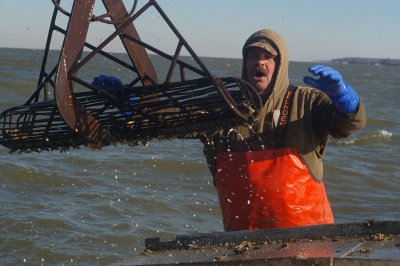
Oysterman Rob Newberry catches his oyster tongs as they come out of the water bearing a mixture of oysters and rocks. Newberry, 50, uses a second boat to charter fishing trips during the summer in order to make ends meet. Working second jobs in the off-season is common among oystermen. (Capital News Service Photo by Kate Elizabeth Queram)
ROCK HALL (March 16, 2008) - During the summer, Chris Lingerman spends his days cutting grass and pruning tree branches. It pays the bills, and gives him a great tan, but it's just a way to pass the time until October 1.
That's the start of the oyster harvesting season, and Lingerman, 35, considers himself, above all things, a waterman. He's been diving for oysters since he was 21. The landscaping is just a "filler job," a way to make ends meet between the conclusion of the last oyster season and the beginning of the new one. And he's not alone.
For years, the decline in the oyster population and the increasing regulations placed on the industry by the Department of Natural Resources have made it difficult for the dwindling numbers of oystermen to make enough money during the season to live on all year.
In order to survive, most oystermen are forced to pursue other activities in the off-season. Some are able to stay on the water year-round by running charter fishing trips or crabbing, but others, like Lingerman, aren't so lucky.
"It takes a lot of equipment to do all these different jobs, and a lot of people starting out don't have all that, so they have to get other jobs during the year," said Larry Simms, president of the Maryland Watermen's Association.
In the last 20 years, the number of licensed oystermen has decreased about 80 percent, with a little more than 300 of them left on the water, said Rob Newberry, an oysterman who frequently testifies in Annapolis about the plight of the industry.
Simms said that DNR regulations have made it increasingly difficult for working oystermen to make money, though he acknowledges the need for some of the regulations.
"The regulations, most of the time, are needed but that's because the [oyster population is] down," Simms said.
The decline in the oyster population has been attributed to a combination of over-harvesting and the presence of diseases that thrive in salt water and kill the oysters at a rate faster than they can reproduce.
The average reported oyster harvest has dropped recently to 104,000 bushels a year, compared to 2.5 million bushels a year from the 1920s to the 1960s.
Suggested solutions to the problem have included introducing disease-resistant non-native oyster species to the bay, but environmental groups and scientists have said this idea requires more research to ensure the new species won't hurt the bay's ecosystem or the native oyster population.
"Clearly, we're very concerned about maintaining our state's culture and commercial harvests, but we also have to make sure that we're protecting the species,'' said Olivia Campbell, media relations manager for DNR.
DNR's regulations include limiting the locations and times that oystermen are allowed to harvest and the number of bushels they can harvest each day. This, Simms said, prevents oystermen who have a slow day from catching up later.
"Let's say I go out today and only catch three to four bushels, and the next day I go out and hit a bunch of oysters," Simms said. "I'm not gonna be able to make up the two days, because I have a daily limit on how many I can catch. It used to be that in peak times that you made up for your lean times, but now you can't make up for your lean times because you've got these limits on you, and that really hampers you."
Oysterman Newberry agreed.
"We have more regulations than you can shake a stick at," he said. "A lot is to preserve the resource, but there are people getting involved who shouldn't be involved."
Newberry said oystermen frequently butt heads with the Coastal Conservation Association, a group that seeks to maintain and restore coastal marine environments.
"They do not like anything that we do," he said.
Robert Glenn, executive director of the Maryland chapter of the Coastal Conservation Association, agreed that the organization is sometimes at odds with oystermen.
"There's a little bit of truth to that," he said. "Our goal is basically more crabs, fish and oysters in the bay. Sometimes, in order to achieve that, there's a human impact. We're not celebrating that but at some point ... you've got to control what we take."
Despite the regulations and restrictions, Newberry is out on the water nearly every day during the oyster season. This includes days in February when the wind whips the water onto the windows of his boat's cabin, where it freezes into patterns like coral that are hard to see through.
"You gotta love it," he said on one such day. "Nobody holds a gun to your head to come out here every day. It's something you gotta love."
The deck of his boat was slippery with icy water and slush, and Newberry donned huge orange waterproof overalls and waddled to a small metal sorting table, where he frequently stands for nine hours as the rusty oyster tongs plunge in and out of the water.
With every dip into the water, the tongs delivered a pile of what looked like oysters, but Newberry tossed the majority back right away. Some, he said, were too small - oysters have to be at least three inches long to be legal for harvest - and others are just rocks.
"This is a big ol' Maryland oyster!" he yelled, holding it up to the light before tossing it into a basket. "I do this for nine hours a day. That doesn't make me crazy, does it?"
After about an hour, he'd only caught a half-bushel of oysters. The DNR daily limit for oystermen is 15 bushels per license, and Newberry said it's easier to make that quota near the beginning of the season because the oyster bars are not as picked over.
When the oyster season ends in late March, Newberry will switch to a second boat to lead chartered fishing groups on the bay. He likes both about equally.
"One washes the other," he said. "Once you're on the water, it's like an addiction. I'm one of the diehards. You'll have to drag me off of here."


